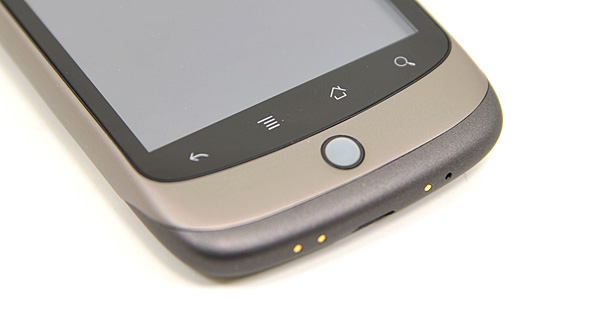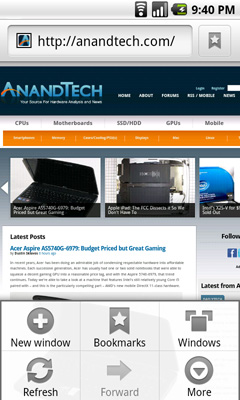Anand's Google Nexus One Review
by Anand Lal Shimpi on April 3, 2010 3:40 AM EST- Posted in
- Smartphones
- Mobile
The Home Bar
The Nexus One has three physical buttons: a power/lock button at the top, volume rocker on the left side and a trackball/button on the face.

The trackball is mostly useless. The Nexus One has a 3.7” multitouch screen for a reason, and it’s way quicker to use the screen than to use the trackpad for scrolling. There are some limited situations where the trackball can be useful, for example while playing games. The iPhone has no useful physical buttons for gaming, the Nexus One’s trackball is better for moving a character around than a virtual d-pad.
Above the trackball there are four touch buttons with fixed functions: back, menu, home and search. By default all provide haptic feedback when activated. In other words, they vibrate a bit when you touch them. It’s a fine feature but it’s nowhere near the feedback you get from physical buttons if that sort of thing matters to you. The buttons also give you the same feedback regardless of whether or not their operation is permitted in the current mode (e.g. hitting the contextual menu button when no such menu exists).
The back button is useful and works as intended, it goes back a screen. The menu button takes some getting used to. The best way I can describe it is like a right click. You get a contextual menu depending on what app you’re running. At the home screen it lets you pop into Android’s settings, add application shortcuts, change wallpaper, view notifications and search. In the email app the contextual menu lets you refresh your inbox, switch to a different folder, change settings, etc...

The contextual menu in Android's Browser app
This is where Android’s more PC-side comes out to play. Apple and Palm for the most part try to keep these sorts of menus away from you. Apps are purposefully not very deep and settings are all controlled through the settings screen, not from within an app. Functionality is driven by the UI. Android takes a more application centric approach. Neither is right or wrong, but both approaches have their pros and cons. I’d argue that Apple/Palm’s approach is better suited for something that’s going to be used as a passive device. Something you’re quickly scanning emails or text messages on. Google’s take is more PC-like. Give the users the options they want, where they want them, even at the risk of UI simplicity.
The Apple method runs the risk of limiting functionality, while Google’s risks turning the UI into a cumbersome mess. Neither is there today, but left unchecked that’s where they’d end up.
Moving on, the home button works as expected, it takes you to your home screen. The search button is particularly interesting because it is one Android feature that Microsoft copied in Windows Phone 7. Hitting the search button brings up an autocomplete enabled Google search box. Hitting go, launches the web browser (very quickly thanks to Mr. Snapdragon) and displays your search results.

What MS is proposing for WP7 are contextual search results that are formatted for the smartphone. Akin to a search app if you will. Search for GeForce GTX 480 and get a normal listing of websites. Search for dentists and get a smartphone formatted list of dentists in your area. Granted MS’ proposal is just that, a proposal, while Android is shipping today. Enabling similar functionality though shouldn’t be hard for Google. I’d love to be able to search, pull results from the web, but have the results presented as more of an app.

Windows Phone 7 Search
The search function will autocomplete things like address book entries, but it won’t automatically search your email for you. While the iPhone’s search function is more focused on searching your device, Android is more interested in helping you search the web. Google has a search engine, Apple doesn’t, the distinction makes sense.










95 Comments
View All Comments
bjacobson - Monday, April 5, 2010 - link
Motorola Droid is no better, my friend has one and OC'd his processor to 1.1Ghz and it still lags just as badly. Both choppy and lags where my finger is. I don't like it at all. This is the main reason I haven't even considered the Android platform yet. I probably will when they fix this.LongTimePCUser - Wednesday, April 14, 2010 - link
Have you tried the Moto Droid after the Android 2.1 upgrade?My experience was that the ui seemed smoother and faster after the upgrade.
eva2000 - Monday, April 5, 2010 - link
bummer about battery life, sounds like nexus rev2 with 1700-1800mah battery in the near future hehhugov - Tuesday, April 6, 2010 - link
I'm not sure the Adreno 200 is as far behind the SGX530/535 as you suggest. The iPhone 3Gs chip (Samsung S5PC100) states in the docs (http://www.samsung.com/global/business/semiconduct... that the GPU is capable of up to 10M triangles/sec, a far cry from the 28M reported in popular press recently. QSD8250 docs suggest up to 22M triangles. And the Adreno is a unified shader architecture GPU with no fixed-function pipes, similar to the PowerVR SGX. OTOH, the *drivers* appear to be quite lacking compared to the PowerVR drivers, at least on Linux/Android.TheHolyLancer - Tuesday, April 6, 2010 - link
I mean wow that dog seems to be focused directly on something above the camera, is that a treat or something?ThePooBurner - Wednesday, April 7, 2010 - link
I really enjoyed reading through this review. I have been wanting to move to a smart phone, but haven't been able to decide what i want. This helps put android devices into perspective in terms of what they can do and what i can expect. I happen to abhor apple, and so i will never own an iphone. I can't stand closed platforms or someone else telling me what i can and can't do with a device that i own. Their stance on "jail-breaking" sickens me. It's like telling me i can't put a new engine in my car if i want to. But that is besides the point. Windows P7 looks like it might be good, but that is a ways off. The Pre-pro looks the most appealing of the phones i have seen reviewed.However, there are 2 devices that i would love to see added to the list of reviewed smart phones: The Nokia n900, and the Samsung Omnia II. For the n900, I would love for you to do a review of it and show us what the Maemo platform can do, as well as a quantifiable battery life test. The phone can do just about everything, but knowing how much doing all of that affects the battery life would be great. The device from a hardware standpoint isn't that different from some of the other smart phones out. It's an Cortex A8 at 600mhz. It's got 32GB of storage (expandable to 48), 5mp camera with flash, WiFi, BT, and it also has an FM transmitter. So on paper it looks great, but there haven't really been any solid reviews on the device from good review sites that use quantifiable testing, or from non-marketing type sites. I know that it also has integration with google voice and google chat. The Omnia 2 has an 800Mhz CPU, and a lot of the same hardware features and uses the TouchWiz 2.0 WM6.5 GUI, which appears to be samsung's platform of choice going forward. It's fairly new so there isn't a whole lot of information out there on this phone yet, but it seems to be marketed as the flagship product from samsung at the moment.
Do you think that you could review these for us? From what i have seen they both look pretty good (though the N900 looks better), but 600$ is a lot to spend without having more than marketing to go off of.
If nothing else this article has at least brought me up to speed on android and it's benefits.
pepsi_max2k - Wednesday, April 7, 2010 - link
"For example, typing yjomh instead of thong won’t autocorrect, although on the iPhone it will. "And I think I speak for everyone, Anand, when I say: Under what situation did you actually find this highly intriguing piece of information out?
SuperFly03 - Thursday, April 8, 2010 - link
Ugh, this review is full of misinformation. I had to say something.http://forum.xcpus.com/blogs/superfly03-341.htm
coolVariable - Thursday, April 8, 2010 - link
1. No mention of the lacking exchange sync.2. No mention of the lacking copy & paste within emails
3. No mention of the connectivity issues.
4. No mention of attachment issues (sending or saving).
5. No mention of file download issues.
...
What a BAD review.
SuperFly03 - Friday, April 9, 2010 - link
I'm not sure what Google phone you are using but the only problem I've had is no. 2. You can't copy paste within emails. I do believe that is a silly limitation but I do not think it is a big problem in the grand scheme of things.No. 1 is complete BS. I have been hooked into my exchange account since day 1 and have never had any issues.
No. 3 is about as generic as you can get. I realize it is a problem that is on the Google sub-forums but likely a firmware issue not an Android issue.
No. 4 and 5 is just laughable.